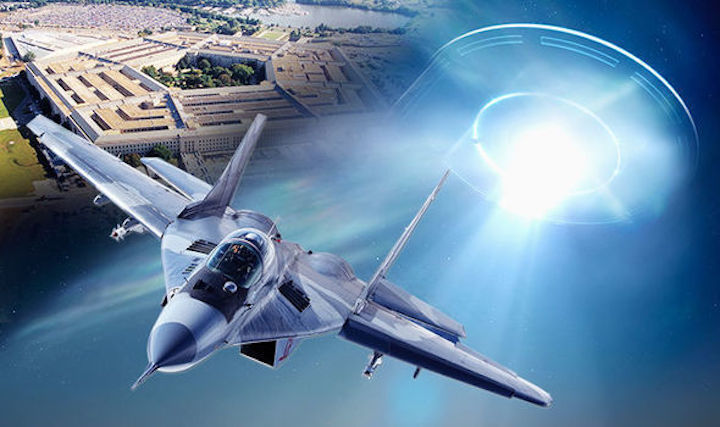25.04.2019

The service says it has also 'provided a series of briefings by senior Naval Intelligence officials as well as aviators who reported hazards to aviation safety.'
The U.S. Navy is drafting new guidelines for pilots and other personnel to report encounters with "unidentified aircraft," a significant new step in creating a formal process to collect and analyze the unexplained sightings — and destigmatize them.
The previously unreported move is in response to a series of sightings of unknown, highly advanced aircraft intruding on Navy strike groups and other sensitive military formations and facilities, the service says.
"There have been a number of reports of unauthorized and/or unidentified aircraft entering various military-controlled ranges and designated air space in recent years," the Navy said in a statement in response to questions from POLITICO. "For safety and security concerns, the Navy and the [U.S. Air Force] takes these reports very seriously and investigates each and every report.
"As part of this effort," it added, "the Navy is updating and formalizing the process by which reports of any such suspected incursions can be made to the cognizant authorities. A new message to the fleet that will detail the steps for reporting is in draft."
To be clear, the Navy isn’t endorsing the idea that its sailors have encountered alien spacecraft. But it is acknowledging there have been enough strange aerial sightings by credible and highly trained military personnel that they need to be recorded in the official record and studied — rather than dismissed as some kooky phenomena from the realm of science-fiction.
Chris Mellon, a former Pentagon intelligence official and ex-staffer on the Senate Intelligence Committee, said establishing a more formal means of reporting what the military now calls "unexplained aerial phenomena" — rather than "unidentified flying objects" — would be a “sea change.”
“Right now, we have situation in which UFOs and UAPs are treated as anomalies to be ignored rather than anomalies to be explored,” he said. “We have systems that exclude that information and dump it.”
For example, Mellon said “in a lot of cases [military personnel] don’t know what to do with that information — like satellite data or a radar that sees something going Mach 3. They will dump [the data] because that is not a traditional aircraft or missile.”
The development comes amid growing interest from members of Congress following revelations by POLITICO and the New York Times in late 2017 that the Pentagon established a dedicated office inside the Defense Intelligence Agency to study UAPs at the urging of several senators who secretly set aside appropriations for the effort.
That office spent some $25 million conducting a series of technical studies and evaluating numerous unexplained incursions, including one that lasted several days involving the USS Nimitz Carrier Strike Group in 2004. In that case, Navy fighter jets were outmaneuvered by unidentified aircraft that flew in ways that appeared to defy the laws of known physics.
Raytheon, a leading defense contractor, used the reports and official Defense Department video of the sightings off the coast of California to hail one of its radar systems for capturing the phenomena.
The Pentagon's UFO research office, known as the Advanced Aerospace Threat Identification Program, was officially wound down in 2012 when the congressional earmark ran out.
But more lawmakers are now asking questions, the Navy also reports.
"In response to requests for information from Congressional members and staff, Navy officials have provided a series of briefings by senior Naval Intelligence officials as well as aviators who reported hazards to aviation safety," the service said in its statement to POLITICO.
The Navy declined to identify who has been briefed, nor would it provide more details on the guidelines for reporting that are being drafted for the fleet. The Air Force did not immediately respond to a request for comment.
Advocates for treating such sightings as a potential national security threat have long criticized military leaders for giving the phenomenon relatively little attention and for encouraging a culture in which personnel feel that speaking up about it could hurt their career.
Luis Elizondo, the former Pentagon official who ran the so-called AATIP office, complained after he retired from government service that the Pentagon's approach to these unidentified aircraft has been far too blasé.
"If you are in a busy airport and see something you are supposed to say something," Elizondo said. "With our own military members it is kind of the opposite: 'If you do see something, don't say something.'"
He added that because these mysterious aircraft "don't have a tail number or a flag — in some cases not even a tail — it's crickets. What happens in five years if it turns out these are extremely advanced Russian aircraft?"
Elizondo will be featured in an upcoming documentary series about the Pentagon UFO research he oversaw. He said the six-part series will reveal more recent sightings of UAPs by dozens of military pilots.
Both Elizondo and Mellon are involved with the To The Stars Academy of Arts and Sciences, which supports research into explaining the technical advances these reported UAPs demonstrate.
Quelle:Politico
---
Anmerkung:
Festzuhalten ist, es eine klare Ansage von Seiten der NAVY gibt, es sich vorab nur um "unidentifizierte Beobachtungen handelt, deren Ursache nicht klar ist aber nicht in Verbindung mit außerirdischen Besuchern steht"! (in Zeiten von Drohnen und neuentwickelten Flugkörpern welche zu Testflügen eingesetzt werden sind irdische Flugkörper realistischer als Besuch von ET.) Und die Exopolitik eines Herrn Luis Elizondo geht jedoch von "außerirdischer Präsenz" aus wie es hier auch in Deutschland Herr Fleischer in seinen Vorträgen und Veröffentlichungen äußert für deren Spekulation es keinen Beweis gibt!
CENAP-Michelstadt
